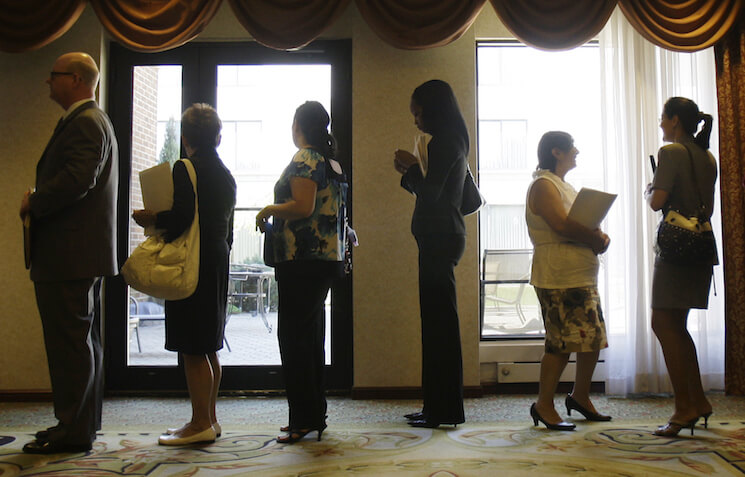Brad DeLong: Worthy reads on equitable growth, October 19–25, 2018
Worthy reads from Equitable Growth:
- I think this is 100 percent correct: Proper conservative thinkers should be focusing not on increasing rates of marriage, but rather on increasing the proportion of people who are marriageable in the sense of having the economic resources and security that make marriage a good idea. When people stay unmarried, it is usually for good reasons. Conservatives may object, arguing it would mean that social democracy was a waypost on the road to attaining conservative family-stability goals. But it looks like that is, in fact, the case. And denying reality is rarely a good idea. This is why you should read Alix Gould-Werth’s “What upticks in U.S. economic inequality and incarceration mean for marriage,” in which she writes: “Increasing inequality in the United States has consequences beyond the material circumstances of those at the bottom of the income distribution … Some experts call for the promotion of marriage. Schneider and his co-authors’ work suggests that these policy proposals may be putting the cart before the horse. If policymakers instead start by improving economic circumstances, rates of marriage are likely to increase. This could lead to a virtuous circle.”
- For most of human history, “women’s work” consisted of jobs that had great flexibility in when and how and in what duration they could be done—gardening, textiles, and so forth. If our organization of work today is not going to have a sharp, disparate impact on women, policymakers need to be working much harder to bring that kind of flexibility to all jobs. Read Elisabeth Jacobs, “Paid Family and Medical Leave in the United States,” in which she writes: “Caregiving needs span the life cycle, and changes in women’s labor force participation in the United States mean that the majority of families no longer have a stay-at-home spouse to provide unpaid care. Yet too many workers who need time off to care for a new baby, a sick loved one, an aging family member, or their own health may do so only at the expense of their own financial well-being—and the cumulative cost of this failure takes a broader toll on the health of the U.S. economy.”
- Greg Leiserson’s stuff on assessing fiscal policy is very good. It should be making a bigger splash. Read his “How should Treasury and the IRS conduct cost-benefit analysis of tax regulations?” Here is his opening presentation of the slides: “The traditional tools of tax analysis are the appropriate tools for the cost-benefit analysis of tax regulations, and that cost-benefit analysis should report estimates of the revenue, distribution, and compliance-cost impacts of a proposed regulation. Social benefits and social costs are not quantified in this approach—and should not be quantified—because doing so would require assumptions about the value of revenues and the appropriate distribution of the tax burden. Treasury and the IRS should not claim to have definitive answers to these questions in a regulatory impact analysis.”
- It is hard to believe that it is now 64 years after Brown v. Board of Education, and we are still inadequately dealing with school segregation. Read Delaney Crampton, “Gerrymandered school districts perpetuate segregation by keeping low-income students out, which is bad for economic growth,” to understand why this is an alarmingly contemporary problem. He writes: “Brown v. Board of Education was the unanimous U.S. Supreme Court ruling that led to the beginning of the end of blatant racial segregation of children in public schools. Actual desegregation took decades to enforce and is still incomplete in many local school districts across the United States. But what’s equally troubling is a new type of segregation in some school districts—gerrymandered school borders that fence out students from economically stressed families, which often means new segregation along racial and ethnic lines.”
- Let me circle back to highlight this again. The persistent and repeated attempts to draw a sharp distinction between equality of opportunity and equality of result do not stand up to even the slightest scrutiny: Read Elisabeth Jacobs and Liz Hipple, “Are today’s inequalities limiting tomorrow’s opportunities?,” in which they write: “Miles Corak found that in countries where inequality is high such as the United Kingdom and United States, there is a strong relationship between a parent and a child’s economic outcomes. Conversely, in countries where inequality is lower such as Norway and Denmark, the relationship between a parent and child’s economic outcomes was not as strong. … The development of human potential is insufficient on its own to power upward mobility. Individuals must also be able to fully deploy their human potential by efficiently and effectively matching opportunities in the labor market. Yet structural changes to the labor market, persistent discrimination, and the importance of parental financial resources in young adulthood prevent the full and effective deployment of human potential.”
Worthy reads not from Equitable Growth:
- The Federal Reserve’s public view of the likely path of the U.S. economy now lacks coherence. This is a bad thing. It may mean that the Federal Reserve’s private view of the likely path of the economy now lacks coherence, in which case policy will lack coherence. It certainly means that market participants can no longer plan on the Federal Reserve having a known coherent view of the economy. Read Joe Gagnon, “Tension Remains at the Heart of the Fed’s Forecast,” in which he writes: “The Federal Open Market Committee (FOMC, or Fed) surprised no one at its September meeting by raising the target for the federal funds rate a quarter of a percentage point to a range of 2 to 2.25 percent. The FOMC has been tightening monetary conditions very slowly since late 2015.”
- Read Sarita Gupta, Stephen Lerner, and Joseph A. McCartin, “It’s Not the ‘Future of Work,’ It’s the Future of Workers That’s in Doubt,” in which they write: “Nearly every discussion of labor’s future in mainstream media quickly becomes mired in a group of elite-defined concerns called ‘The Future of Work.’ … Rarely has a phrase been so ubiquitous in discussions of the economy or social policy … [but] it is the concentration of wealth and power in this new economy, not computerization or artificial intelligence, that represents the gravest threat to our future.”
- The must-read of must-reads on the links between behavioral finance and macro: John Maynard Keynes (1936): “The State of Long-Term Expectation,” in which he wrote: “If I may be allowed to appropriate the term ‘speculation’ for the activity of forecasting the psychology of the market, and the term ‘enterprise’ for the activity of forecasting the prospective yield of assets over their whole life, it is by no means always the case that ‘speculation’ predominates over ‘enterprise.’ As the organisation of investment markets improves, the risk of the predominance of speculation does, however, increase.”
- Read Antonio Fatás, “Europe’s fiscal policy doom loop,” in which he writes: “The damage done by procyclical fiscal policy in the euro area between 2010 and 2014 is likely to be even larger … Fiscal policymakers … created a ‘doom loop’, with unfounded pessimism feeding into policy … the consequences of those policies increasing pessimism … hysteresis, permanently reducing GDP.”
- Read Jiahua Che and Yingyi Qian, “Insecure Property Rights and Government Ownership of Firms,” in which they write: “We develop a theory of the ownership of firms in an environment without secure property rights against state encroachment. ‘Private ownership’ leads to excessive revenue hiding, and ‘state ownership’ (i.e., national government ownership) fails to provide incentives for managers and local governments in a credible way … ‘Local government ownership’… may better serve the interests of the national government.”
- A very interesting study of what appears to be highly successful job search assistance in Nevada. Read Day Manoli, Marios Michaelides, and Ankur Patel, “Long-Term Effects of Job-Search Assistance: Experimental Evidence Using Administrative Tax Data,” in which they use “Administrative tax data [to] examine the long-term effects of an experimental job-search assistance program operating in Nevada in 2009.”





